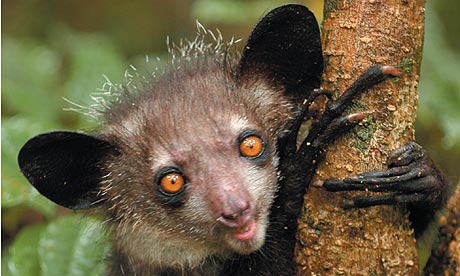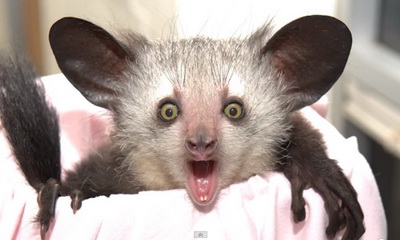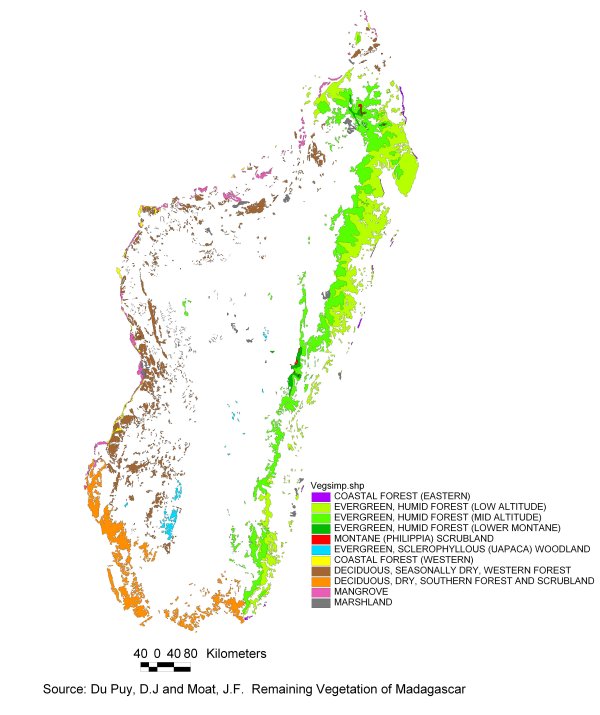I am going to kick off this blog with one of my favorite animals, the Aye-Aye. I am particularly drawn to this case of human-wildlife conflict because there is an interesting cultural aspect to it that isn't commonplace; the Aye-Aye itself isn't commonplace either. Unfortunately, not too much is being done about the conflict with the Aye-Aye that is going on in Madagascar. If you know of any specific efforts or programs in place to help them, please let me know.
What is an Aye-Aye?
The Aye-Aye (Daubentonia madagascariensis) is a special (and specialized) lemur, and like all lemurs it is only found in Madagascar. It’s the largest nocturnal primate in the world, the only known primate to use echolocation, and the only extant species in the genus Daubentonia and family Daubentoniidae. Those last two facts might tip you off to the fact that it's pretty weird as far as primates go. Nobody knows their population size for sure, but there is an estimated 1,000-10,000 left in the wild, making them rare; they were at one time thought to be extinct but were rediscovered in 1957-- which probably made scientists mad because that meant they had to classify it in all its weirdness. .
The Aye-Aye has a bizarre (and I think endearing) appearance due to its special adaptations, which allow them to inhabit the same ecological niche as the woodpecker (i.e. they penetrate wood and extract invertebrates). Except, instead of using a woodpecker-like beak for foraging, they use a long, weird middle finger to tap a tree, their sharp buck teeth to gnaw a hole in the tree, then the long finger again, with a sharp hook-like nail, to fish out grubs. They also have leathery, bat-like ears that are capable of independent rotation; and also like bats, use echolocation, which helps them locate grubs while they're drumming away at the tree bark. This method of foraging, tapping and listening for cavities in trees, is called percussive foraging, and they're the only primate to use it (there is a great video of them foraging for grubs here, on the National Geographic video site). Top all this off with their squirrel-like characteristics of continuously growing teeth (actually, a characteristic of all rodents), a large bushy tail, and sleeping in nests and you've got yourself one confusing primate. So confusing that for many years scientists thought it was a rodent!
These unique characteristics are important, not only because they're awesome adaptations that allow them to utilize a niche that is unique for a primate, but I also have a sneaking suspicion that their appearance might have something to do with why the locals are so freaked out by them, though I have no confirmation of this. See their appearance and judge for yourself:
An Aye-Aye baby:
They kind of look like weird flightless bats, right?
Source unknown
|
| Look at that finger! |
 |
This guy's too happy to care about the local's judgment
Source: The Guardian. Edward E Louis Jr.
|
Threats
The Aye-Aye has two primary threats to worry about. Like many species, habitat loss is the major cause for it’s decline. But unlike most other species in peril, the locals think it is a harbinger of death, and consequently kill it.
Superstition
You can read in depth about local superstition surrounding the Aye-Aye in a great article from Lemur News here. In summary, there is some variation in the lore surrounding the Aye-Aye, but the central point to most of it is that seeing an Aye-Aye = death or illness, and many people who believe this handle it by killing them on sight. And after killing them, they either hang the Aye-Aye, or its tail, on a pole by the crossroad, believing that when strangers pass by the dead Aye-Aye they will carry the bad luck away with them. (Wait, so it's okay if strangers are cursed? That's not very nice, Malagasy folks!) In some places, people even go as far as abandoning their villages if one enters it. Granted, not everybody in Madagascar believes in the superstition about the Aye-Aye, but enough do that it is a problem for the species, which is Near Threatened according to the IUCN Redlist. One silver lining to this superstition is that because locals believe the Aye-Aye is bad luck, they usually don’t hunt it for food (with a few exceptions), because nobody wants bad-luck food.
 |
Source: Wikimedia Commons. Thomas Althaus
An Aye-Aye killed by the Malagasy in hopes that
the evil spirit will be carried away by travelers
(read more about this superstition in the Lemur
News article linked above)
|
Sadly, the problem of Aye-Ayes entering villages, and consequently agitating local superstition, can only be exacerbated by habitat loss, which often leads to animals roaming outside their habitat to forage for food. But why is their habitat being destroyed?
Slash-and-burn agriculture
Around 80% of the population in Madagascar are subsistence farmers. The main crop they grow is rice (though they are no longer self sufficient and need to import rice as well), and judging from the map below, rice fields comprise the majority of agricultural land. Cash crops such as coffee, sugar, vanilla, cloves, and cotton are also grown on the island by commercial farmers. In order to convert rain forests (the Aye-Aye's primary habitat) into agricultural land they use a technique called tavy, better known as slash-and-burn agriculture. Typically, an acre or two is burned and a crop is grown there for a couple of years until the nutrients are depleted from the soil. Then the land is left fallow until the forest grows back and the process is repeated, which can take up to 20 years.
This was sustainable through most of Madagascar's history, but now that the population has grown (the population growth rate is currently around 3%), more and more of the land is being used for this and the result is sometimes tragic. When the slashed-and-burned plots of land are too large, they cannot be recolonized by seeds from surrounding trees because there are none. Because of this, areas of nutrient depleted wasteland persist. As a result of this type of agriculture around 10% of Madagascar's historical forest remains. Here is a map of Madagascar's agricultural areas and the crops that grow there:
 |
Source: nationmaster.com's Madagascar page
|
 |
| Source: IUCN |
As you can see, their range isn't very extensive, maybe 10% of the island, which largely coincides with the only remaining rain forest:
Further, virtually all of the crops listed on the agriculture map overlap with the range of the Aye-Aye in someway. So, who is in the way? The Aye-Aye or the farmers? The farmers seem to think the Aye-Aye.
 |
This Aye-Aye is horrified
Source: unknown
|
Conflict with humans
Here is a map of the population density of Madagascar, which, keeping in mind the habitat map from above, shows that their habitat passes though some of the highest density areas on the island:
 |
Source: nationmaster.com's Madagascar page.
|
Their proximity to humans and cropland, in conjunction with their dwindling habitat, results in them raiding crops and being shot by farmers. They're pretty successful crop raiders, with one story linking them to an 80-100% destruction of coconut crops in two villages. And, as mentioned earlier, in villages that believe in the local superstition of the Aye-Aye being bad luck, when the Aye-Aye enter's a village, or sometimes if seen in the forest, they kill them. I also imagine that the local Aye-Aye superstition exacerbates their treatment as crop pests, though I can't find sources for that. But, logic says (to me) that if an animal is already hated, then when it does something remotely negative (e.g. enter farm land, even if not eating anything) then people will feel more compelled to kill it than, say, a cuter species of lemur.
Resolution
As far as I am aware, there is not much being directly done to reduce the conflict between the locals and the Aye-Aye. But, again, if you happen to know of any programs, let me know. It is illegal to kill them but whether or not this law is enforced is questionable. As compared to habitat loss, the killing by locals is much less of a threat, but when there is possibly only 1,000 left in the wild, each individual represents much more. But, what could be done to protect them? Here are a few ideas
- Education of the local people to dispel superstitions surrounding the Aye-Aye.
- Formulation of methods for farmers to use to prevent Aye-Ayes (and other lemurs) from raiding their crops, or a simple and effective way to chase them off.
- Promotion of eco-tourism to give locals a monetary reason to respect the local wildlife.
- Due to the fact that Madagascar is one of the poorest coutries in the world, a government program to compensate farmers who lose crops to Aye-Aye raiding would also be a good idea. If they know that they will receive compensation for their losses, they may be less likely to kill crop raiders.
As far as general Aye-Aye conservation goes, they are listed in CITES Appendix I, which lists species that are threatened with extinction and states that any trade in the species requires import and export permits.They are also present on 16 protected areas in Madagascar, and apparently more money is going into protecting Madagascar's wildlife and wildlands than any other part of Africa.
Thanks for reading the first installment!

Hi! thanks for writing. I hope that more people will open their eyes.
ReplyDeleteThis is really nice blog which you shared with us if you want to go for a wildlife safari so just visit on this link- Thanks for your lovely blog which helps us a lot if you are searching for a packers and movers so just visit on this link- wildlife tour in Corbett
ReplyDeleteThanks and that i have a keen supply: How To Plan House Renovation house renovation tax deduction
ReplyDeleteI find it fascinating how unique and specialized this lemur is.
ReplyDelete